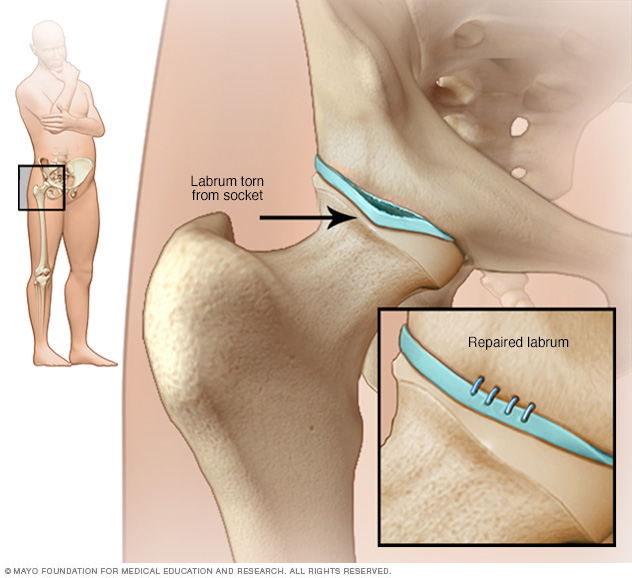Overview
Hip labral tear

Hip labral tear
Hip labral tears are more common in people who play certain sports or who have structural problems of the hip. If conservative treatments don't help, a health care provider may suggest surgery to repair the torn labrum.
A hip labral tear involves the ring of cartilage (labrum) that follows the outside rim of the hip joint socket. Besides cushioning the hip joint, the labrum acts like a rubber seal or gasket to help hold the ball at the top of the thighbone securely within the hip socket.
Athletes who participate in sports such as ice hockey, soccer, football, golf and ballet are at higher risk of developing hip labral tears. Structural problems of the hip also can lead to a hip labral tear.
Products & Services
Symptoms
Many hip labral tears cause no signs or symptoms. Some people, however, have one or more of the following:
- Pain in the hip or groin, often made worse by long periods of standing, sitting or walking or athletic activity
- A locking, clicking or catching sensation in the hip joint
- Stiffness or limited range of motion in the hip joint
When to see a doctor
Seek medical attention if symptoms worsen or don't improve within six weeks.
Causes
The cause of a hip labral tear might be:
- Trauma. Injury to or dislocation of the hip joint — which can occur during car accidents or from playing contact sports such as football or hockey — can cause a hip labral tear.
-
Structural problems. Some people are born with hip issues that can accelerate wear and tear of the joint and eventually cause a hip labral tear. This can include having a socket that doesn't fully cover the ball portion of the upper thigh bone (dysplasia) or a shallow socket, which can put more stress on the labrum.
Extra bone in the hip, called femoroacetabular impingement (FAI), can also cause pinching of the labrum, which can lead to tearing over time.
- Repetitive motions. Sports-related and other physical activities — including long-distance running and the sudden twisting or pivoting motions common in golf or softball — can lead to joint wear and tear that ultimately result in a hip labral tear.
Complications
A hip labral tear can make it more likely that you'll develop osteoarthritis in that joint.
Prevention
If the sports you play put a lot of strain on your hips, condition the surrounding muscles with strength and flexibility exercises.
Feb. 05, 2022
- Frontera WR, et al., eds. Hip labral tears. In: Essentials of Physical Medicine and Rehabilitation: Musculoskeletal Disorders, Pain, and Rehabilitation. 4th ed. Elsevier; 2019. https://www.clinicalkey.com. Accessed Oct. 2, 2021.
- Johnson R. Approach to hip and groin pain in the athlete and active adult. https://www.uptodate.com/contents/search. Accessed Oct. 2, 2021.
- Su T, et al. Diagnosis and treatment of labral tear. Chinese Medical Journal. 2019; doi:10.1097/CM9.0000000000000020.
- Nori S, et al., eds. Hip pain. In: Clinical Diagnosis in Physical Medicine & Rehabilitation. Elsevier; 2022. https://www.clinicalkey.com. Accessed Oct. 2, 2021.
- Krych AJ (expert opinion). Mayo Clinic. Oct. 14, 2021.
Related
Products & Services